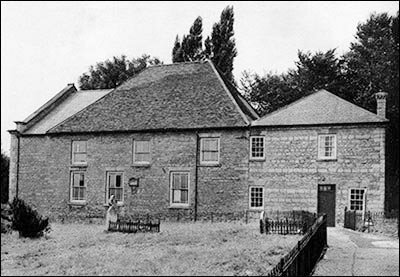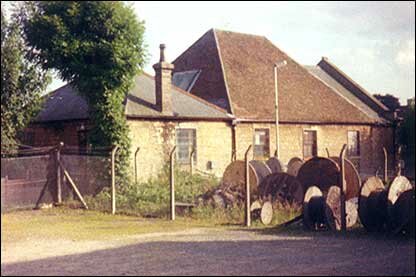|
|
||||||||||
| Kay Collins 2007 |
||||||||||
|
Old Baptist Church
"Top Meeting" |
||||||||||
|
The Old Baptist Church the early years. |
||||||||||
|
||||||||||
|
The Compton Census of 1676 states that 600 Conformist and 6 Non-conformists worshipped in Rushden. Just four years earlier the “Declaration of Indulgence Act” had allowed for John Bunyan to be released from gaol and his followers were soon meeting openly. His Church at Bedford had started a branch at Stevington in 1655 and now with the freedoms this Act brought, the members from that village began to visit their surrounding villages to further the Baptist cause. In 1701 Martha Groom widow & Henry Herbert yeoman applied for a Meeting House certificate. [see letter above - the Church existed in 1715] The earliest Church Book at Rushden dates from 1723 when the meetings were held in Mr Wullaston’s house, which stood in a yard behind several cottages in Little Street, and this was later converted into the Meeting House. This little book documents much of the church business and the membership until the new church was built in 1901 in Park Road. The first deacon of the church was John Fisher. In 1749 William Knowles of Keysoe came to join the church when the covenant had been re-written and only 11 people signed. William often led the services and in June 1752 he was ordained as pastor and was cherished by his congregation. His first wife Elizabeth was buried at St Mary’s and the vicar noted “wife of a dissenting teacher” in May 1766 and he married a church member Hannah (or Anna) Howkins at St Mary’s Church in 1768 (non-conformists were not yet licensed to perform marriages) and his son John (from his first marriage) was a witness along with John Abbott.
In 1777 two cottages in Little Street were for sale and after collecting subscriptions the money was raised for the purchase. The gardens were used to provide a pathway to the church and space for a burial ground and the houses were rented out to provide income. By 1796 the membership was increasing and the need for an extension led to the cottages being sold to raise the necessary funds.
At the turn of the 19th century there was a trend to less strict principles and a breakaway group left the church and was known as “The Bottom Meeting”, the original group were referred to as “The Top Meeting”. The new group built a new church in the High Street in 1805 called the Succoth Church. At this time Rev John Peacock arrived and The Top Meeting rose to 200 during his pastorate. The Church had 88 members in 1810 and now decided to drop their claim for support from the Particular Baptist Fund after nearly 50 years. In 1813 the members signed a petition to Parliament, asking for a clause in the Charter of East India Company to give safety to Baptist Missionaries. A Sunday School was established in 1810 in the home of John Knowles where the gateway in Little Street was later made into the churchyard. The cottage with others was burnt down one Sunday in 1860 when the congregation was with the Wesleyans for worship during the renovation and expansion of the Meeting House. The Sunday School used the vestry for a time and then moved into the Chapel and much of the time was spent in teaching the children to read and learning to sing the hymns Mr Samuel Knight precentor and lessons conducted by a superintendent. The first class learnt the alphabet from letter cards, class 2 spelling from cards, class 3 spelling from “The Lower Spelling Book”, class 4 spelling from “The Higher Spelling Book”, class 5 the Testament and class 6 The Bible. Children joined this school at the age of 6 and it was possibly the first school as the Church of England set the age at 5 for scholars enrolling at their school. The Baptists then lowered the age to five in 1830 and by 1840 there were 27 teachers. The custom was to leave at 14 years of age and pupils were then presented with a Bible. In 1843 the school joined with others to form “Thrapston & District Sunday School Union” and membership brought a gift of books from the National Society in London consisting of “12 Bibles, 9 large Testaments, 6 small Testaments, 40 first class books, 20 second class books, 20 third class books, 20 Scripture reading books, 21 alphabets in wood, 8 of first, second & third class question books for uses of the Teachers, 9 sheets of paper for 1st class, the alphabet in rhyme”. There were now 30 teachers and 140 scholars at this school where discipline was also taught. A new schoolroom and vestry were built in 1860 and the school had grown to 186 and the following year an infant class was started with William Gross, Mary Freeman & Ebenezer Knight appointed to run it. Families from Podington also began to send their children to the school.
The Rev James Bean came in 1826 and over the next 3 or 4 years 23 were expelled or suspended and members drifted away to the Bottom Meeting where Charles Drawbridge, a young man of 21 was drawing new members. Membership began to increase once again when Mr Jonathan Whittemore came as minister in 1832. He had already established himself with a publishing business and transferred it into a factory (formerly Mr Kidgell’s) which he converted into a printing office. (He was the first to sign the Temperance Pledge in Rushden). In 1847 these commercial concerns caused Mr Whittemore to be gaoled for debt and there followed a disagreement amongst the elders of the Church as to his remaining as pastor. Twelve were suspended and together they set up a Meeting House in Sept 1848 at Dial Farm, the home of George Day. A barn on the premises of Mr J F Knight in the High Street was fitted out and the Elim Church was founded there but when the lease ran out (about 1872) the church was disbanded. Some returned to the Old Meeting but others went to the Succoth further up the High Street. Mr Whittemore left in 1851 and in 1857 he started “The Christian World” and in 1860 founded “The Sundays School Times”. The Baptist Church was now firmly established and in 1901 built a smart new Church in Park Road. Based on three books: “The Romance of a Northamptonshire Baptist Church” by Rev W F Harris (minister 1899-1909) and written to commemorate the opening of the new church; he also edited the first edition of the magazine “The Rushden Baptist”. Herbert Lack followed him as editor and he wrote another history in 1910 on “The Work & Workers of a Hundred Years” to celebrate the centenary of the Sunday School. In 1951 a further history “These Years Have Told” was written by George Bayes. |
||||||||||



